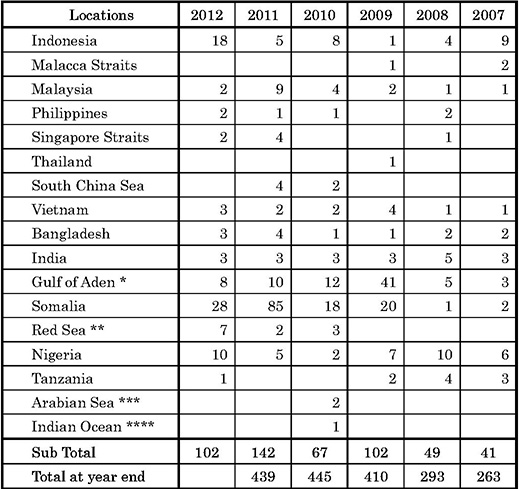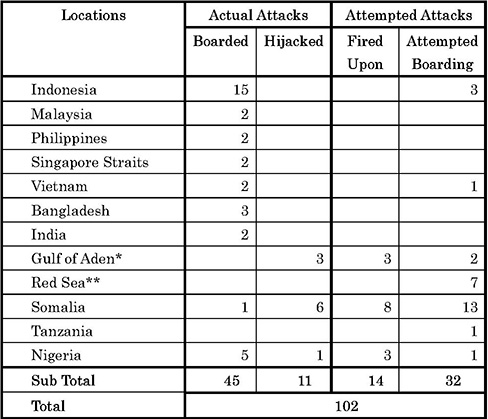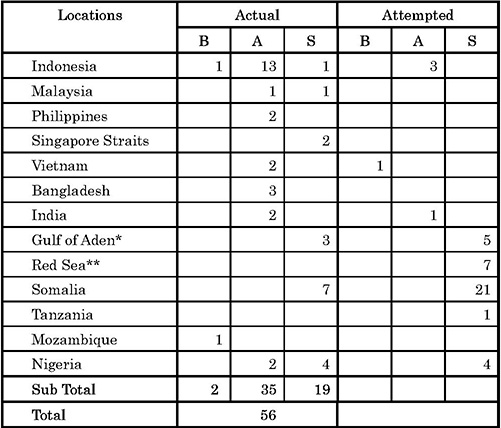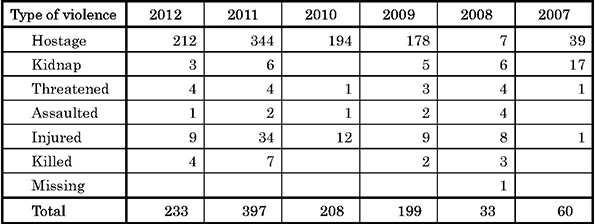Piracy and Armed Robbery against Ships up to 1st Quarter of 2012
-Characteristics viewed in the IMB Report-
Hideshi UENO,Research Fellow, Ocean Policy Research Foundation
Contents
On April 23, the International Maritime Bureau (IMB) of the International Chamber of Commerce (ICC) published a report through the Piracy Reporting Center (PRC) based in Kuala Lumpur on the incidents of piracy and armed robbery against the ships noted in the world up to the first quarter of 2012 (January 1 March 31, 2012). Below is a summary of the characteristics of the incidents of piracy and armed robbery against the ships viewed from the IMB report (hereinafter referred to as the Report) noted in the first quarter of 2012.
Regarding the definition of Piracy and Armed Robbery against Ships, the IMB accepts the “definition of piracy” in Article 101 of the United Nations Convention on the Law of the Sea (UNCLOS). As for the armed robbery, the IMB accepts the definition of the “Code of Practice for the Investigation of the Crimes of Piracy and Armed Robbery against Ships” which was adopted by the International Maritime Organization (IMO) in its Assembly session in November 2001.
(In view of circumstances for the descriptions, related Tables and Charts were carried en bloc at the end of the report.)
1. Characteristics viewed from numbers and locations of the incidents (including attempted attacks)
The number of the incidents reported in the first quarter of the year 2012 was 102 (142 during the same period in 2011). Looking at the monthly number of the incidents, June marked the highest number at 41. There were 35 incidents in February and 26 incidents in March. Of them, 56 were actual attacks. Of them, 11 were hijackings, and 56 incidents were boarding. There were 46 attempted attacks. Of them, 14 cases were firing and 32 were attempted boarding. However, the IMB is regarding there are a great number of the unreported cases apart from the reported cases, advising the shipping owners and masters of the ships to report all piratical attacks and suspicious movements of the crafts to the bureau.
A total of 102 incidents reported in the first quarter of the year 2012 showed a large decrease, compared with 142 incidents (439 incidents throughout the year of 2011) noted during the same period in 2011. The trends of attacks during each first quarter of the recent six years are as shown in the Table 1. Looking at the attacks by location, of 102 incidents, 71 incidents which occupy 70% of the total have occurred in the five areas as follows. Looking at the cases in order of higher frequency, there were 28 incidents off Somalia (including the Indian Ocean), 18 incidents in Indonesia, 10 incidents in Nigeria, eight incidents in the Gulf of Aden, and seven incidents in the Red Sea.
According to the Report, the number of incidents in the Gulf of Aden, off Somalia (including the Indian Ocean) and the Red Sea in the surrounding waters of the “Horn of Africa” totals 43, which distinctly indicates a large number of incidents attributed to Somali pirates surrounding area of the Horn of Africa. Compared with 93 during the same period of 2011 (16 hijackings), the number of the incidents decreased by half. However, the Report says that there is no evidence to suggest that the danger from Somali piracy is likely to go away. According to the Report, of 43 attacks, nine hijacked incidents (three in the Gulf of Aden and six off Somalia, including the Indian Ocean), one boarded incident (off Somalia including the Indian Ocean) were noted. 152 seafarers have been taken hostage and one has been injured and two killed. As of March 31 2012, Somali pirates hold 15 vessels for ransom with 253 crew members as hostages, with an additional 49 crew members being held on land as hostages.
According to the Report, the attack area by Somali pirates continue to expand, and it covers the southern part of the Red Sea in the west to 76 degrees East longitude and beyond in the east. Incidents have also been reported off the coast of Oman/Arabian Sea in the north extending southward to 22 degrees. In these waters Somali pirates are also using hijacked ocean going fishing vessels, merchant vessels and dhows as “mother vessels” (hijacked vessels include four dhows and one fishing vessel) to conduct piracy operations. With pirates in control of these mother vessels, there is no boundary that the pirates could not sail to with fuel onboard. Somali pirates expands their operational area to off Kenya, off Tanzania, off Seychelles, off Madagascar, off Mozambique, the Mozambique Channel, Arabian Sea, off Oman, the Gulf of Oman, off Indian west coast, and off Maldives.
On the other hand, the Report evaluates that the overall number of incidents and the hijack success rate have reduced due to the deployment of naval vessels from respective nations to waters in the Gulf of Aden, and preventive measures used by the merchant vessels including the use of citadels, evasive maneuvers taken by vessels in accordance with the anti-piracy manual of the Best Management Practices (BMP), and employment of Privately Contracted Armed Security Personnel (PCASP).
Meanwhile, as shown in the Table 1, in Asia, the number of incidents in Indonesia has increased to 18 cases (15 were boarding and three were attempted boarding). This represents a steep increase from five cases during the same period in 2011. Most attacks were boarding while vessels were berthed or anchored at night, which were robberies at a low level as pirates/robbers usually abort when spotted. There were three cases in Vietnam including two actual attacks and one attempted attack. The actual attacks were conducted ships at anchor during the night and the attempted attack was an aborted robbery. Except two attacks against sailing vessels (one was boarding and the other was attempted boarding a chemical tanker) in the Singapore Strait, most incidents in Asia occurred in port.
2. Characteristic viewed from activities
The Table 2 shows the status of attacks by location noted frequently in the areas in Asia and others up to the first quarter of 2012. The Table 3 shows the status of ships attacked, including the attempted cases, by location in 2012.
According these data, the feature of the attacks by Somali pirates is clear. The incidents, including the attempted attacks, by Somali pirates in the Gulf of Aden, Red Sea, Arabian Sea, and off Somalia including the Indian Ocean, occurred while the ship were steaming. These incidents show the feature of Somali pirates that they attack the steaming ships by “mother vessels” and skiffs − small high speed boats. On the other hand, in case of Asia, as for a posture attacks, most were boarded attacks, and in most cases they were attacked while the ships were anchored.
On the other hand, in the first quarter of 2012, there were four locations where more than three incidents were reported in ports and anchorages, totaling 14 incidents. According to the Report, four locations in the first quarter of 2012 include Dumai, Indonesia, and Lagos, Nigeria with four attacks respectively, and Abidjan, Ivory Coast, and Chittagong, Bangladesh with three attacks respectively.
As for the types of vessels attacked (including those of attempted attacks) during the first quarter of 2012, the highest number of attacks at 21, including attempted attacks, was recorded on bulk carriers. The following were 19 chemical tankers, 17 containers, 11 crude oil tankers, six general cargos, five product tankers, four dhows, two fishing vessels, and others. The Report points out that the vessels attacked were targets of opportunities, and pirates did not necessarily target the specific vessels by type.
Looking at the ships attacked by nationality, of all incidents of 102 cases in the first quarter of the year 2012, the highest number of attacks at 19 was made on Liberia-flagged vessels, 17 were on Panama-flagged vessels, 14 were on Singaporean-flagged vessels, five were on Bahamas-flagged vessels, five were on Marshall Islands-flagged vessels, and five were on Hong Kong-flagged vessels. In case of Japanese-flagged vessels, in the past six years, one vessel was attacked during the same period in 2011.
On other hand, looking at the operational status of the ships attacked by nationality of the countries, where victim ships were controlled/managed, the highest number falls on Singapore with 24 vessels. Singapore is followed by Germany with 17 vessels, Greece with 12 vessels, Hong Kong with eight vessels, India with six vessels. Japan has one attack.
3. Types of violence to crew and peculiarities of weapons used
Looking at the status of violence to crew, as shown in the Table 4, in the past four years, the incidents in which the crews were taken hostage have dramatically increased, which occupies a greater part of violence. During the first quarter of 2012, 212 persons were taken hostage, which considerably decreased with decreasing the number of hijacking incidents, compared with the same period in 2011. On the other hand, looking at the violence by locations, of 212 hostage incidents in the first quarter of 2012, there were 118 cases in Somalia, 34 cases in the Gulf of Aden, 24 cases in Nigeria, 18 cases in Benin, 11 cases in the Singapore Straits, five cases in Indonesia, and others. The incidents by Somali pirates occupy a greater part of the incidents. From a perspective of human violence, this area abounds in many cases of demanding ransom for the hostages, which shows a peculiarity of the attacks by Somali pirates.
The Table 5 shows types of arms used by pirates in the incidents which occurred during the respective first quarter of the recent six years. Looking at this chart, you will find few changes in the trend that guns and knives are major arms of pirates for the past six years. On the other hand, looking at the types of arms to be used by pirates by location, of 48 attacks in which guns were used, 20 cases in Somalia, eight cases in the Gulf of Aden, and three cases in the Red Sea were noted. The incidents by Somali pirates occupy a greater part of the incidents (10 cases in Nigeria). This will make us find how dangerous the Somali pirates armed with AK-47rifles and RPG-7 rocket weapons are. In cases of Asia, knives, not guns, were mainly used. In Indonesia, of 17 cases, one gun, six knives, and nine cases not stated were noted. In Malaysia, of two cases, one gun and one knife were noted. In the Singapore Straits, one gun and one not stated were noted.
Table 1: Trends of incidents (including the attempted attacks) that occurred frequently in Asia and other areas in January − March, 2007 – 2012

Source: Made from Table 1 in the IMB Piracy and Armed Robbery against Ships (1 January − 31 March, 2012), p. 5. The total of the incidents covers all area in the report.
Note: *; Gulf of Aden, **; Red Sea, ***; Arabian Sea, ****; Indian Ocean, all of the above attacks are attributed to Somali pirates.
Table 2: Status of attacks frequently noted in Asia and other areas in January − March, 2012

Source: Made from Table 2 in the IMB Piracy and Armed Robbery against Ships (1 January − 31 March, 2012), p. 8. The total of the incidents covers all area in the report.
Note: *; Gulf of Aden, **; Red Sea, all of the above attacks are attributed to Somali pirates.
Table 3: Status of ships attacked (including the attempted cases) by location in January − March, 2012

Source: Made from Table 4, 5 in the IMB Piracy and Armed Robbery against Ships (1 January − 31 March, 2012), pp. 9-10. The total of the incidents covers all area in the report.
Note: *; Gulf of Aden, **; Red Sea, all of the above attacks are attributed to Somali pirates.
Table 4: Type of violence to crew in January − March, 2007 – 2012

Source: Made from Table 8 in the IMB Piracy and Armed Robbery against Ships (1 January − 31 March, 2012), p. 11.
Table 5: Types of arms used during attacks in January − March, 2007 – 2012

Source: Made from Table 7 in the IMB Piracy and Armed Robbery against Ships (1 January − 31 March, 2012), p. 10.
From “Intelligence Analysis (April 2012)”
関連記事
